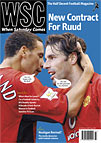 As the anti-racism organisation celebrates its tenth birthday, Tom Davies spoke to Kick It Out co-ordinator Piara Powar about progress made and the battle still ahead
As the anti-racism organisation celebrates its tenth birthday, Tom Davies spoke to Kick It Out co-ordinator Piara Powar about progress made and the battle still ahead
With the well established Kick It Out campaign now ten seasons old, it’s easy to forget just how marginal an issue anti-racism in football once was. In the 1980s it took the brave efforts of supporters themselves, often at the places with the worst reputations such as Leeds and Chelsea, to drag the issue to public prominence. And it’s tempting, now, to congratulate ourselves on just how far we’ve come.
“As a nation we have become more aware,” says Kick It Out’s national co-ordinator, Piara Powar. “The situation is very different to ten years ago, but we still hear of incidents of racial abuse and even monkey chanting.” The shift of emphasis by racist groups towards asylum and immigration also poses challenges. Powar warns: “The presence of the BNP in towns such as Oldham and Burnley inevitably has a direct spillover into football stadia, so while you may not have the far right leafleting grounds as much as they once did, they do see football fans as a captive audience.”
For all the progress, crowds remain overwhelmingly white. Fewer than one per cent of Premiership season-ticket holders are black or Asian. Ethnic minority attendance at Nationwide League grounds is generally even lower. Yet grounds often sit in poor, multiracial areas. But the people who stand to benefit most from the decline of explicit racism often find themselves priced out of attending.
Powar agrees that high prices are a hindrance, but argues that some of the changes that have taken place in the past decade have been beneficial: “There are more women at games now, grounds are safer places to be. But the cost of that has been prices keeping local people away. There’s a commercial argument to be made that if the clubs engaged more with people from ethnic communities they could potentially spend as much at the club as everyone else. But I do think that clubs need to think about offering reduced prices.”
Cost, clearly, isn’t everything though. The club with comfortably the most multiracial following in England is, after all, Arsenal. Powar feels that Arsenal benefit from a fluid local population, which contains the white working and middle classes living among a large and varied ethnic community. But other clubs are in similar surroundings. Why have they not been as successful? “The clubs have got to have a serious commitment. They have to engage with schools in the right way. The standardised coaching schemes they run, for example, are often far too expensive. They’ve got to engage in the right way and for the right reasons.”
Having a cosmopolitan trophy-winning side also helps, as does the presence of star players with whom to identify. “At Arsenal there was the Ian Wright factor,” says Powar. “He was one of the most widely admired black players in the 1990s, and that’s been continued with Thierry Henry.”
Smaller clubs, on the other hand, cannot sell themselves on stars and playing honours and must rely on history. “Racism, or fear of racism, might not be as much of a factor as it used to,” says Powar, “and lower down people might be able to afford to go, but there might be other things. It might be about a cultural space – they feel the club is not for them. Immigrants arrive in an area and cannot cite the same historical fervour about a club that other fans can.”
Exclusion doesn’t just happen in the stands, of course, and Kick It Out is lobbying strongly around racism at grass-roots level as well as at the higher echelons of the game, where management, coaching and administration are overwhelmingly a white preserve. The organisation also intends to step up its campaigning around England games, though the national side’s black support has increased. “The Japan World Cup was notable for a new attitude of ‘white shirt, no shame’, whereas before a lot of black and minority fans generally were backing off and automatically supporting Brazil, or perhaps France. This has been a very distinct change,” says Powar.
But while it would be daft to pretend we’re dealing with the same problems as in 1986 or even 1994, we must be aware that complacency is not an option.
From WSC 205 March 2004. What was happening this month